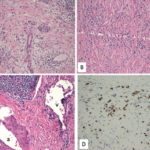According to Dr. Gelfand, neurosarcoidosis commonly presents with cranial neuropathy, especially of the optic nerve, facial nerve and vestibulocochlear nerve. Although rarer than cranial neuropathy, leptomeningitis and pachymeningitis are also common phenotypes of neurosarcoidosis.
“Hydrocephalus is an important complication, often of chronic meningitis in neurosarcoidosis,” said Dr. Gelfand, noting that it often occurs with leptomeningitis and may require a shunt. “Stroke from, and due to, sarcoidosis as opposed to occurring co-morbidly in someone with sarcoidosis is rare, but can also occur,” concluded Dr. Gelfand.
Dr. Gelfand then discussed advances in treatment for neurosarcoidosis, including data supporting tumor necrosis factor (TNF) inhibitors for neurosarcoidosis. He ended his presentation by underscoring the association between TNF inhibitor exposure and inflammatory central nervous system events. For example, according to Dr. Gelfand, TNF inhibitors are associated with an increased risk of both demyelinating and non-demyelinating central nervous system events. Given what is known about the risk of harm, Dr. Gelfand therefore suggested avoiding TNF inhibitors in patients with a diagnosis of multiple sclerosis.
Patients who develop new, concerning neurological symptoms while receiving treatment with TNF inhibitors, should be evaluated in a timely manner, with consideration of neuroinflammation, as well as infectious and neurological diagnoses that may be unrelated to treatment.
Dermatology
Anthony P. Fernandez, MD, PhD, director of medical dermatology at the Cleveland Clinic presented an update on dermatologic manifestations of sarcoidosis. He described the current understanding of the clinical features of patients with cutaneous sarcoidosis, discussed progress in the objective clinical assessment of sarcoidosis, and reviewed current and emerging treatment strategies for cutaneous sarcoidosis.
According to Dr. Fernandez, most patients have cutaneous manifestations at the time of diagnosis of systemic sarcoidosis and erythema nodosum may be the first presenting symptom of systemic sarcoidosis. Although the incidence of cutaneous sarcoidosis is not well defined, “what we do know,” said Dr. Fernandez, “is that African Americans have the highest rates of sarcoidosis in the U.S. and are more likely to have chronic cutaneous sarcoidosis than white Americans.”
Women also develop cutaneous disease more often than men.3
Dr. Fernandez also explained that an increasing number of medications is reported to induce cutaneous sarcoidosis and sarcoid-like granulomatous eruptions. Among such medications are interferon-α (IFN-α), immune checkpoint inhibitors, targeted kinase inhibitors and TNF inhibitors.4
According to Dr. Fernandez, although sarcoidosis may have different cutaneous presentations, the most common forms include papules, plaques, papulonodules, lupus pernio and subcutaneous nodules. Less common presentations are ichthyosiform, atrophic and ulcerative lesions, and mucosal lesions.



